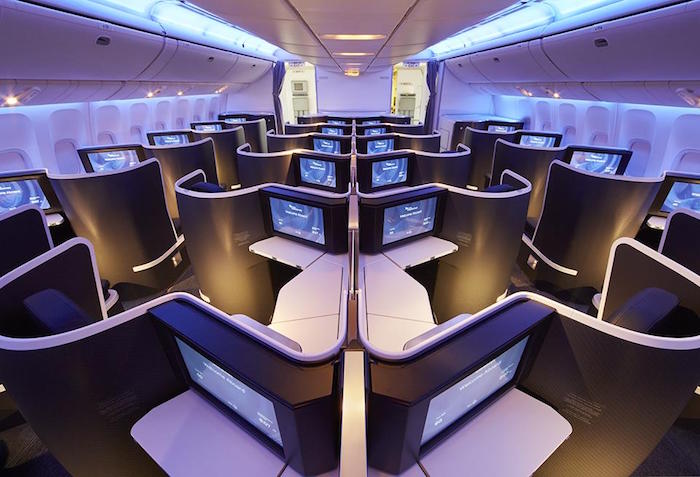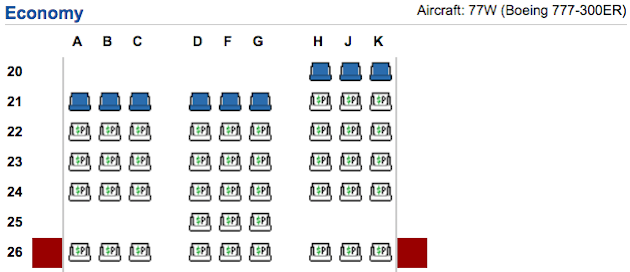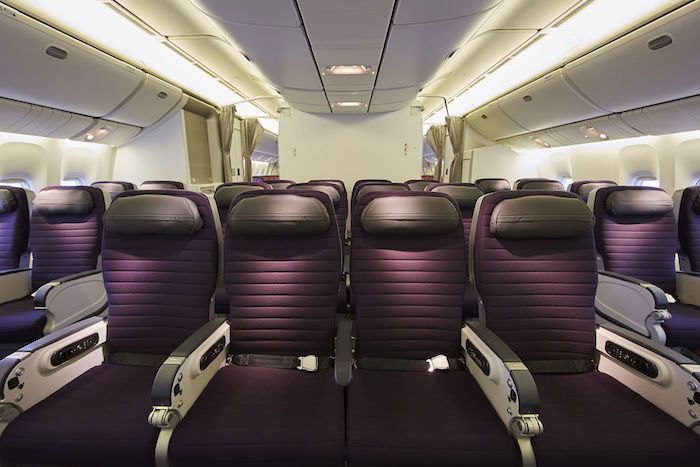There are two types of “premium” economy products, which some consumers get confused:
- Some airlines have premium economy on longhaul flights, which are similar to domestic first class; the seats are wider, there’s more legroom, the meal service is expanded, etc.
- Some airlines have extra legroom economy, which are standard economy seats with more legroom; sometimes they’ll come with enhanced service, like on Delta, where they offer free drinks and snacks to those passengers
Historically foreign carriers have been the industry leaders with premium economy, while US carriers have done the most to embrace extra legroom economy seating.
But that’s slowly changing. For example, American and Delta will soon be adopting premium economy cabins.

American’s new Premium Economy

American’s Main Cabin Extra
It’s not just US carriers adopting premium economy, but foreign carriers are also starting to adopt extra legroom economy. It looks like Virgin Australia will be introducing extra legroom economy seating on their Boeing 777-300ER aircraft. The new cabin is called Economy Space+, and will be available for flights commencing August 30, 2016 (presumably by then most of Virgin Australia’s 777-300ERs will be reconfigured, as the first one was just completed).

Virgin Australia’s gorgeous new Business Class
Economy Space+ will consist of the first five rows of economy, as well as the exit rows.

It will come with the following features:
- Extra legroom
- Check-in via a dedicated Premium check-in counter
- Pre-boarding
- Preferred overhead locker
- Dedicated crew members throughout the flight
- Guaranteed first meal choice
- Premium noise-cancelling headset
Pricing will be between 135AUD and 165AUD (~98-120USD) one-way. Virgin Australia won’t be offering this product for free to their elite members, best I can tell. At first I figured this may be a new reciprocal offering given their transpacific alliance with Delta, given that they have Comfort+, but that doesn’t seem to be the case in terms of elite recognition.
Interestingly Virgin Australia is reducing the size of their premium economy cabin as they’re reconfiguring their planes, from 40 to 24, which is the first time I recall an airline cutting back on the premium economy concept.
At the same time Virgin Australia is changing the way they market premium economy. Virgin Australia will begin just calling premium economy “premium,” to further the image they’re trying to create of it truly being something between economy and business class.

Virgin Australia’s Premium Class
I’m curious to see if other international airlines follow with extra legroom economy seating. There really does seem to be a market for it, given the huge price difference between economy and premium economy. There are plenty of people willing to pay $100-150 for a one-way upgrade, but not $500+.





@SeaFlyGuy the economy layout in VA is 3-3-3 while premium is 2-4-2.
please review air newzeland premium economy as there new hard product looks very nice, also would be interested in the meal quality and ground service
As a VA Plat I had a look at the seat map for a new-config-operated flight after the intro date for Space+. It does appear that they will be charging elites full price for the Space+ seats at time of booking. The mini-cabin was previously reservable by only by status-holding passengers and traveling companions; the status-based block remains, but the elite sections are now located just aft of door 3.
@SeaFlyGuy I can't see any photo with 10 across?
I've flown the B777 with both 9 (Qatar) and 10 (Emirates) seats abreast, as well as the B787 (Qatar) which is 9 abreast and honestly the difference was negligible. Now Air Asia A330's 9 abreast, that's a tight squeeze for a 8-10 hour flight.
CX also removed a row of premium economy on their A330s which fly to Australia and also removed it completely on aircraft to India and middle East.
$100 is cheap. That is roughly the same as what DL, AA and UA charge for E+, C+, MCE on domestic transcons.
For now, I am a fan of these Econ plus or extra space or w/e they are called, seats. I think as long as they are reasonably priced (and to me a 100 bucks on way is worth it, with what you get, with the exception of United) I will keep paying for it. Though I know eventually they will cut back benefits of it and keep upping the price of it. But for now, I am a fan of these airlines adapting this.
I don't prefer extra legroom, but I would love extra recline. I like to jam my knees into the seat in front of me when I don't have a footrest to help keep me from sliding down the seat.
DL does have another 5cm of recline in their extra-legroom economy product. That looks pretty nice. AA MCE, on the other hand, has exactly the same seats and same recline as any other seat on the...
I don't prefer extra legroom, but I would love extra recline. I like to jam my knees into the seat in front of me when I don't have a footrest to help keep me from sliding down the seat.
DL does have another 5cm of recline in their extra-legroom economy product. That looks pretty nice. AA MCE, on the other hand, has exactly the same seats and same recline as any other seat on the plane (except some 9/10-across 777s, which have some economy-minus seats that are even narrower). That's a garbage quality offering for a ten hour or longer flight.
So the arrival of premium economy to US carriers is very welcome. Width and recline can make a journey so much better. Foot rests are surprisingly much more comfortable than knee jamming, too.
So is this 9-across as shown on the seat map, or hell-on-earth 10-across as shown in the photo? I don't care if I have 36" of seat pitch if my seat is 16.8" wide and my shoulder is jammed up against the guy next to me, and half my body is spilling out into the aisle, to be constantly bumped by service carts with 1/4" clearance on either side. 10-across on 777 should be illegal.
@ Sebastian:
Virgin Aus is just reducing capacity. THY has pretty much removed it entirely. Which is too bad, it was quite comfy for a very reasonable premium and great mileage accrual.
Actually, Virgin Australia is not the first to reduce their Y+ capacity; Turkish did it previously too.